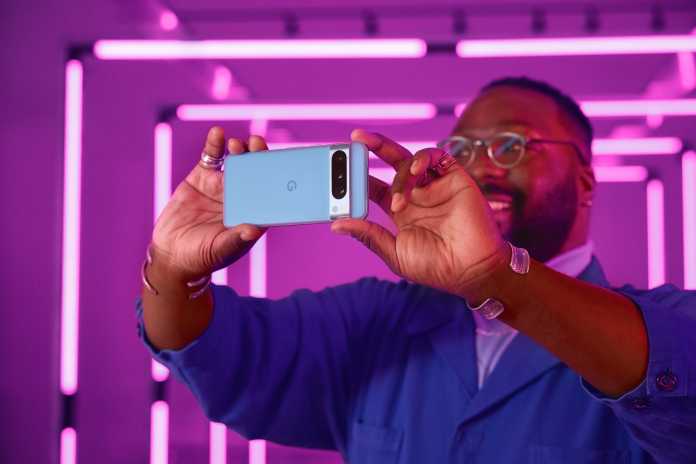Advertisement
At this year’s “Made by Google” event in New York, everything revolved around the Pixel smartphones, which Google has now introduced in its eighth generation. As in the past, there is a normal model and a slightly larger and better equipped Pro variant. Visually, the new cell phones remain true to the design language and have the unmistakable camera bar on the back, which, like the 7th generation, is made of aluminum. Google makes the case frame from recycled aluminum, while the back is made from Gorillaglass. On the Pixel 8 it is glossy, the 8 Pro has a matte back, which is already familiar from the Pixel Fold.
The Pixel 8 has an OLED display with a diagonal of 6.2 inches (157 mm) and is therefore slightly smaller than the Pixel 7. The resolution has remained the same at 1080 x 2400 pixels. Like its predecessor, the Pixel 8 Pro has a screen diagonal of 6.7 inches (170 mm) and a resolution of 1344 x 2992 pixels. Google has improved the display technology: While the 7th generation phones achieved a short-term peak brightness of 1400 cd/m2, the Pixel 8 has 2000 cd/m2 and the 8 Pro 2400 cd/m2, which means that both smartphones also have a direct brightness Sunlight should be easy to read. The adjustable luminance is 1400 or 1600 cd/m2. The Pixel 8 Pro still offers a variable refresh rate in an interval of 1 to 120 Hertz. The Pixel 8 has 60 to 120 Hz – its predecessor managed a maximum of 90 Hz.
Solid equipment
Both Pixel 8 models use the Tensor SoC, which Google developed together with Samsung. In the third generation it should deliver more performance than its predecessor. However, Google has not yet given any details about the number of CPU cores – according to rumors, the Tensor 3 will have nine cores with a clock frequency of 3 GHz for the strong Cortex-X3, 2.45 GHz for the four medium Cortex-A715 and 2.15 GHz with the four weak Cortex-A510s.

The Pixel 8 Pro costs at least 1100 euros.
(Image: Google)
However, the 8 GB of RAM for the Pixel 8 and 12 GB of RAM for the Pixel 8 Pro have been confirmed. Google offers the small model with a storage capacity of 128 or 256 GB. The 8 Pro comes with 128, 256 or 512 GB. The battery capacity of the Pixel 8 has grown moderately to 4,575 mAh. For the Pixel 8 Pro, Google puts the capacity at 5,050 mAh. Both smartphones are charged on chargers that support USB Power Delivery 3.0 with a maximum of 30 watts, so they should reach a charge level of 50 percent after 30 minutes. Both phones also support wireless charging according to the Qi standard.
As with previous Pixel generations, the small model has to make do with one less camera sensor. The main camera on both Pixel 8 models has a 50-megapixel sensor with a pixel size of 1.2 µm and an 82-degree field of view and an aperture of f/1.68. The two models differ when it comes to the ultra wide-angle camera. The Pixel 8 has 12 megapixels, the 8 Pro has 48 MP. The field of view is identical for both at 128.8 degrees. The Pixel 8 Pro also has a third 48MP camera with a telephoto lens with 5x optical zoom and 30x software zoom. In addition, Google states that the camera app on the Pixel Pro should offer users more setting options. The 8 Pro also gets a function called “Video Boost”, which, similar to the previous night mode for photos, is now intended to bring out more light in videos.
Android 14 with extras
Both smartphones will be delivered with Android 14, which is about to be released. As before, Google has added some functions to the operating system that are reserved for Pixel phones. Some of them are also dedicated to beautiful photos. In addition to the already established “Magic Eraser”, which uses AI to automatically remove disturbing image elements from photos, there is the “Magic Editor” announced at Google I/O, which moves individual image elements and can also change their size.
For portraits, the Unblur function, which automatically sharpens faces in blurry photos, is now available as “Best Take”. The series photo function uses AI to extract all faces in group photos and, if necessary, inserts them into the finished photo so that everyone is smiling and looking into the camera.
Elsewhere, AI is intended to increase comfort and increase productivity. This means that the Google Assistant on the Pixel 8 phones can read out and translate websites that are open in the Chrome browser. In English-speaking countries it is also able to summarize the content of a website.
The most pleasing news about the software for users is probably that Google has significantly extended the support period for the Pixel 8. The smartphones receive not only security updates for the next seven years from the start of sales, but also operating system updates and quarterly feature drops, which subsequently add new functions.
Both phones can be ordered now. The Pixel 8 with 128 GB starts at 799 euros and costs 859 euros with 256 GB. The Pixel 8 Pro costs 1,099 euros (128 GB), 1,159 euros (256 GB) and 1,299 euros (512 GB). This means that both models are noticeably more expensive than the 7th generation models.
(spo)
